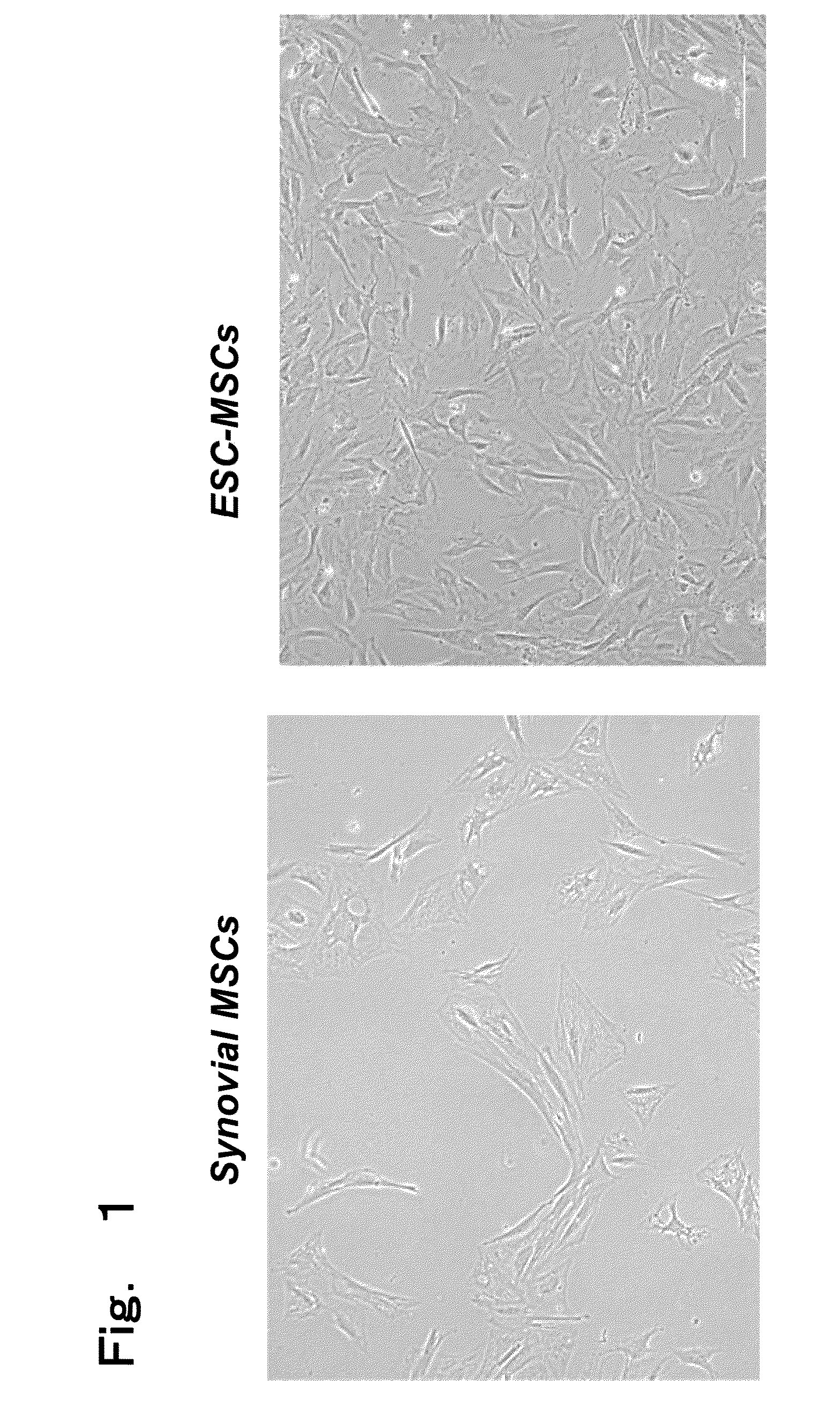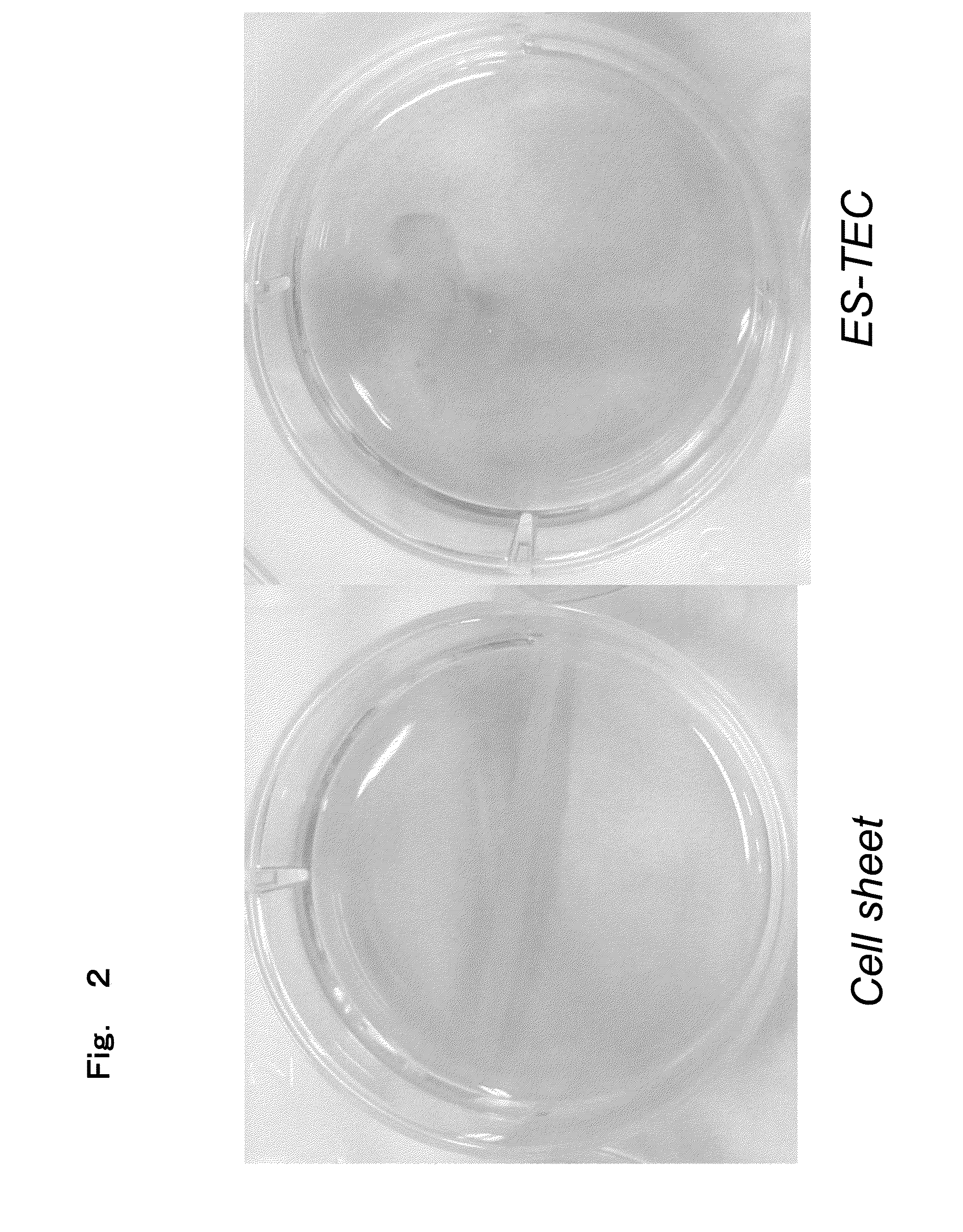Creation of three-dimensional synthetic tissue from pluripotent stem cell-derived cells, and osteochondral regeneration treatment using said synthetic tissue
a technology of pluripotent stem cells and synthetic tissue, applied in the field of regenerative medicine, can solve the problems of inability to develop practical implantable synthetic tissue, tissue is poorly integrated with extracellular matrix, and single sheet obtained by this technique is often fragile, so as to achieve excellent effect and speed, and prevent unnecessary ossification. , the effect of ensuring safety
- Summary
- Abstract
- Description
- Claims
- Application Information
AI Technical Summary
Benefits of technology
Problems solved by technology
Method used
Image
Examples
production example 1
Production of Three-Dimensional Synthetic Tissue Using Synovial Cells
[0311]In this example disclosed below, a three-dimensional synthetic tissue was produced by using various synovial cells used as a comparative example.
[0312]
[0313]Synovial cells were collected from a knee joint of a pig (LWD ternary hybrid, 2-3 months old upon removal of cells), followed by treatment with collagenase. The cells were cultured and subcultured in a 10% fetal bovine serum+High Glucose-DMEM medium (fetal bovine serum available from HyClone, DMEM was obtained from GIBCO). It has been reported that 10th passage synovial cells still have pluripotency. Although cells of 10 or less passages were used in this production example, it is understood that cells of more than 10 passages may be used depending on the application. Autotransplantation was performed for actual human implantation, but it was necessary to secure a sufficient number of cells and to culture the cells for a short period of time so as to redu...
production example 2
Production of Three-Dimensional Synthetic Tissue Using Cells from Adipose-Derived Tissue
[0330]Next, cells derived from adipose tissue were used to produce a synthetic tissue.
[0331]A) Cells were collected as follows.
[0332]1) A specimen was removed from the fat-pad of a knee joint.
[0333]2) The specimen was washed with PBS.
[0334]3) The specimen was cut into as many pieces as possible using scissors.
[0335]4) 10 ml of collagenase (0.1%) was added to the specimen, followed by shaking for one hour in a water bath at 37° C.
[0336]5) An equal amount of DMEM (supplement with 10% FBS) was added, followed by filtration using a 70 l filter (available from Millipore or the like).
[0337]6) Cells which passed through the filter and residues which remained on the filter were placed and cultured in a 25 cm2 flask (available from Falcon or the like) containing 5 ml of DMEM supplemented with 10% FBS.
[0338]7) Cells attached to the bottom of the flask (including mesenchymal stem cells) were removed and sub...
production example 3
Production Example with Human Synovial Cells
[0347]Next, a synovial cell is collected from a patient having an injured meniscus to determine whether the synovial cell can be used to produce a synthetic tissue.
[0348](Collection of Synovial Cell)
[0349]A human patient, who is diagnosed by an imaging technique as having a cartilage injury or meniscus injury, is subjected to arthroscopy under lumber anesthesia or general anesthesia. In this case, several tens of milligrams of synovial membrane are collected. The collected synovial membrane is transferred to a 50-ml centrifuge tube (manufactured by Falcon) and washed with phosphate buffered saline (PBS). Thereafter, the sample is transferred to a 10-cm diameter culture dish (Falcon) and is cut into small pieces using a sterilized blade. Thereafter, 10 ml of 0.1% collagenase (Sigma) is added to the cut pieces. The dish is shaken in a constant temperature bath at 37° C. for 1 hour and 30 minutes. To the solution, 10 ml of medium (DMEM, Gibco...
PUM
| Property | Measurement | Unit |
|---|---|---|
| size | aaaaa | aaaaa |
| thickness | aaaaa | aaaaa |
| of time | aaaaa | aaaaa |
Abstract
Description
Claims
Application Information
 Login to View More
Login to View More - R&D
- Intellectual Property
- Life Sciences
- Materials
- Tech Scout
- Unparalleled Data Quality
- Higher Quality Content
- 60% Fewer Hallucinations
Browse by: Latest US Patents, China's latest patents, Technical Efficacy Thesaurus, Application Domain, Technology Topic, Popular Technical Reports.
© 2025 PatSnap. All rights reserved.Legal|Privacy policy|Modern Slavery Act Transparency Statement|Sitemap|About US| Contact US: help@patsnap.com



